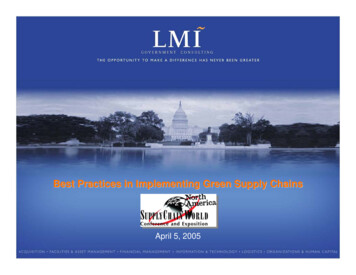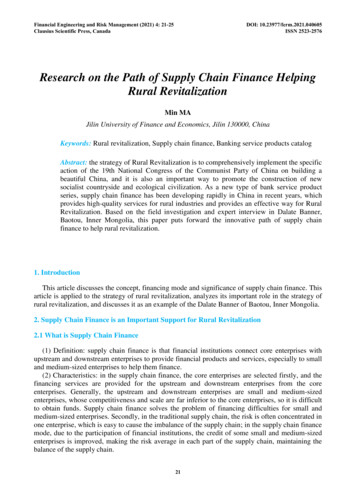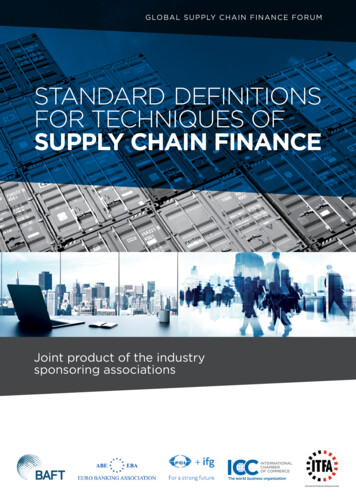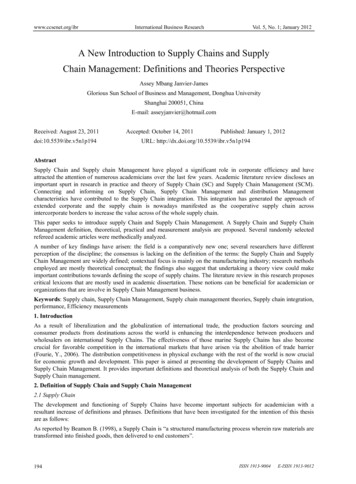
Transcription
Supply Chain Finance andTechnologySolving the Working Capital ChallengeSeptember, 2020Copyright 2020, Oracle and/or its affiliatesPublic
DISCLAIMERThis document in any form, software or printed matter, contains proprietary information that is the exclusive propertyof Oracle. Your access to and use of this confidential material is subject to the terms and conditions of your Oraclesoftware license and service agreement, which has been executed and with which you agree to comply. This documentand information contained herein may not be disclosed, copied, reproduced or distributed to anyone outside Oraclewithout prior written consent of Oracle. This document is not part of your license agreement nor can it be incorporatedinto any contractual agreement with Oracle or its subsidiaries or affiliates.This document is for informational purposes only and is intended solely to assist you in planning for the implementationand upgrade of the product features described. It is not a commitment to deliver any material, code, or functionality, andshould not be relied upon in making purchasing decisions. The development, release, and timing of any features orfunctionality described in this document remains at the sole discretion of Oracle.Due to the nature of the product architecture, it may not be possible to safely include all features described in thisdocument without risking significant destabilization of the code.2WHITE PAPER Supply Chain Finance and TechnologyCopyright 2020, Oracle and/or its affiliates Public
TABLE OF CONTENTSDisclaimer2Introduction4Supply chain finance for a demand-driven world4Challenges of supply chain finance4The failure of legacy technology5Emerging tech to the rescue6Conclusion83WHITE PAPER Supply Chain Finance and TechnologyCopyright 2020, Oracle and/or its affiliates Public
INTRODUCTIONFor years, business leaders in the corporate banking industry have been seeking ways to leverage technology to maketheir Supply Chain Finance programs future-ready. The current pandemic has exposed the shortcomings of outdatedplatforms and has emerged as a catalyst for the transformation of Supply Chain Finance.Legacy Supply Chain Finance systems were not built to meet the increasingly dynamic supply chain requirements ofbuyers and suppliers. While these legacy systems are good at performing activities, for which they were prepared andoptimized, they lack the agility, integration, and visibility needed for today’s fast-changing demands and businessconditions. Furthermore, traditional systems employ fairly rigid and entrenched approaches. Modern Supply ChainFinance systems on the other hand, enable innovative, responsive, and continuously improving supply chain financepractices. These systems can provide the analytics; automation, collaboration and seamless integration that you need tostreamline your supply chain finance process, shorten time-to-value and, control costs.Access to working capital is a key and growing challenge for businesses. The challenge is further exacerbated with theimpact of the pandemic on credit and financing options, and tougher times likely lie ahead. To plug this financing gap,alternative funding solutions, including Supply Chain Finance have emerged and are growing in popularity. Corporatebanks are increasingly looking to turn Supply Chain Finance into a revenue- generating engine.SUPPLY CHAIN FINANCE FOR A DEMAND-DRIVEN WORLDThe post-pandemic world is going to be different. Temporary trade restrictions,shortages and delivery challenges meant buyers were delaying payments to oldpartners or quickly adding new suppliers.While some things will change a lot remains the same. Customers will continue toface working capital and cash flow challenges because of lengthy payment waitingperiods. The pressure to operate efficiently and use capital frugally to remaincompetitive will continue to burden corporate firms.Banks aren’t lending at the same volumes they were before the pandemic andexperts believes they may never lend at the same volumes again. At the sametime, slow payment increases the demand for smart working capital management.To address their growing working capital needs in an unfavorable financinglandscape, companies are increasingly looking for alternative financing methods.Supply Chain Finance has emerged as an attractive option for improving workingcapital positions across the supply chain.Consequently, banks need to take theonus of enabling corporates to connect efficiently with their financial supplychains in order to optimize their working capital and mitigate risks.A recent analysis, found Supply Chain Finance is gaining a stronghold globally bydelivering more than 50 % of the Global Trade revenue. This figure presents hugebusiness opportunities for banks, as corporates are looking for ways to unlock andoptimize their working capital confined in their supply chains.BenefitsThe benefits that come with SupplyChain Finance are profound.The benefits to the buyer include theability to:: Offer a financing option withimproved borrowing costsImprove days payable outstandingStabilize the supply chainThe Suppliers benefit from the ability to: Gain from an alternate source ofliquidityAccelerate paymentsReduce days sales outstandingLower financing costsThe Banks gain ability to: Acquire new customers - supplierswho gain financingTap new revenue streams fromfinancingExplore cross-sell opportunitiesCHALLENGES OF SUPPLY CHAIN FINANCEDespite the growing popularity, there are several challenges in Supply Chain Finance. For many banks, disjointedsolutions and outdated spreadsheets are still the go-to tools and, have entailed a lengthy, paper-laden, labour-intensiveprocess. It’s not just high costs and revenue loss for both corporates and banks. With orders placed across a range ofsystems and coming from various geographies, it causes delay in the entire Supply Chain Finance lifecycle, which in turncan lead to disappointed customers.4WHITE PAPER Supply Chain Finance and TechnologyCopyright 2020, Oracle and/or its affiliates Public
All these factors combined with pressure from new market entrants, more stringent compliance, KYC checks and AMLrequirements, drastically impeded the adoption of Supply Chain Finance. Here are some of the challenges thatbusinesses might face on a daily basis:CHALLENGESDESCRIPTIONOPERATIONAL IMPACTPaper heavy processesFlow of physical paper documents acrossborders throughout the transaction cycle Increase in transaction turnaround timeHandling & storage costsRisk of losing or tampering importantdocumentsLabor intensive Manual checking is subjective & errorproneLack of standardization acrossgeographies makes it difficult to scaleoperationsStaff development is critical which maytake as many as 6 months to 7 yearsHigh staff turnover and relativeinexperience increases operational risksand leads to client dissatisfaction Authenticity of paper documents isverified manuallyManual handoffs across fragmentedoperational processes and IT systems Stringent regulatory &financial crimecomplianceBasel III, Dodd Frank, Foreign Account Tax Compliance Act (FATCA) and AML requirebanks to invest heavily in systems andprocedures to deter, detect and protect from money laundering FundingThe absence of guaranteed payment due tolittle or no clarity on the counterparty andabsence of payment default rules Enhanced due diligence, KYCcompliance, Sanctions screening hasintroduced costly manual checksReliance on 3rd party providers likeWorld Check, Sea Searcher, Blacklistcheck, Defaulters list check increasesmanual handoffs and turnaround timeNonstandard reporting processes andformats for adhoc transaction reportingto regulatorsDelayed or no paymentSource: Deloitte ReportTHE FAILURE OF LEGACY TECHNOLOGYEarly Supply Chain Finance adopters are finding their once cutting-edge systems aren’t nimble enough to keep up withthe pace of change. The limitations and complexities of legacy systems tend to cause significant operational challengesin today’s global and connected Supply Chain scenario. 5Limited in the information age: Legacy systems by nature are rigid, clunky, and complex and this createschallenges around service consistency, and documentationSiloed data: There are many banks operating on multiple systems to handle different activities of the SupplyChain Finance lifecycle. As these systems have poor integration and interface capabilities, it creates a majordisconnect in the flow of data which increases the time required to find relevant information, thereby,hampering decision makingBusiness blind spots: Lack of departmental collaboration as legacy systems fail to connect Supply ChainFinance solutions with other third-party systemsVisibility gaps: Buyers and suppliers expect transaction data at their fingertips. But, some of the information islikely to be inaccessible or inaccurateTime-to-market and documentation bottlenecks: Lost documents and process delay will lead to delays inprocessing invoices and financesError prone processes: Manual reconciliation process that relies on spreadsheets is prone to human errors andcan increase the risks to loss of revenue and fraudsWHITE PAPER Supply Chain Finance and TechnologyCopyright 2020, Oracle and/or its affiliates Public
Lack of transparency and controls: Conforming to external regulatory bodies and internal compliance checkscan be a daunting task for banks if the supply chain finance lifecycle processes lack transparencyStuck in the past: With legacy systems, banks have limited access to emerging technologies like MachineLearning (ML), and digital assistantsEMERGING TECH TO THE RESCUESupply Chain Finance has always been complex, requiring the integration of multiple processes, applications,technologies, and collaboration among supply chain participants. Deploying emerging technologies reduces thesechallenges significantly. It’s time to let go of legacy monolithic systems and embrace digital transformation withsolutions built on componentized architecture.Digital transformation in Supply Chain Finance will play a very crucial role in empowering corporate banks to providesupply chain finance services at lower costs and at a higher efficiency level.The defining traits of a Modern Supply Chain Finance application: 6Integrated: Creates more efficient, low-friction supply chain finance processes, shorter time-to-value andprovides end-to-end visibility into transactions. Seamless integration across the Supply Chain Finance lifecyclemeans standalone systems, time-consuming and inaccurate manual processes are all a thing of the pastOrchestration: Technology-based collaboration will empower banks and other entities to make quickerdecisions and complete supply chain finance services in shorter times. Future-ready applications provide endto-end visibility right, from buyers to the supplier to counterpartiesAgile: Reacts quickly to market changes with the ability to make continuous, dynamic, real-time adjustmentsIntelligent: Leverages Machine Learning (ML) to automate supply chain finance processes that previouslyrequired human monitoring and manual intervention.User experience: Responsive and intuitive, and gives users digital self-service options.Open platform: Adopts micro services architecture to accommodate upgrades and improvements, andfacilitates integration with other applicationsDigital: Drives digitization throughout the entire supply chain finance lifecycle that is burdened with laborintensive paperwork and documentation processes to keep up with the demand-driven world of digital supplychain operating modelsAutomation: Uses Optical Character Recognition (OCR), Machine Learning (ML) and Natural LanguageProcessing (NLP) technology to convert documents into e-documents without any human interventionWHITE PAPER Supply Chain Finance and TechnologyCopyright 2020, Oracle and/or its affiliates Public
Why should you consider using a Digital Supply Chain Finance system.to replace your legacy system? Consider thesebenefits:FUNCTIONALITIESBENEFITSBusiness processautomationAutomated process workflows improve task management and increases productivityConnected experienceSeamless multi-channel experience removes all channel barriers impacting customersatisfaction Centralized system 7Enables integration with back-office and front-office applicationsEnsures meeting ever-increasing regulatory requirementsEnables parallel processingEnables Integration with external vendors and credit bureaus to perform customeridentification, AML and KYC checksFaster and more transparent onboarding experience Flexible productconfigurationEnables faster processing of supply chain finance transactionsProvides greater convenience with ability to set up parametersReduces cost and improves the speed of communicationSeamless third-party integration for quicker turnaround and collaboration betweenparticipants Seamless onboardingSingle, unified system for reverse factoring, supplier finance, payable finance,receivable finance and more360 degree view of customerEnsures capturing only the required data ‘one time’Ensures faster turnaround timeEnhances operational efficiency and reduces manual errors Third-party APIintegrationProvides customers with the self-service abilityAllows use of different access points to begin & complete processEnables consistency of experience across touch-pointsCentralized operations capability enables reuse of customer data & application services Paperless processingEnsures Straight-through processing to reduce operational costEliminates redundant manual processesMaximizes automation and enables faster fulfillmentEnables real-time visibility into transactionsAllows onboarding a customer and their counterparts along with its basic detailsFlexible options to define wide range of product attributes enables banks to enhancecustomer experience Enables banks to create different Supply Chain Finance products with severalvariations on the fly, thereby empowering banks for faster time-to-market Enhances customer experience as customer preferences are metWHITE PAPER Supply Chain Finance and TechnologyCopyright 2020, Oracle and/or its affiliates Public
CONCLUSIONThe need for sustainable Supply Chain Finance programs to support access to working capital for businesses cannot beoverstated. Notably, Supply Chain Finance programs balance the disparate needs of both buyers and suppliers. Despitethe global trade disruption, the worldwide revenues from Supply Chain Finance grew in the first quarter of 2020, andpresents corporate banks with a potentially new avenue for growth.In this post-pandemic environment, innovation, efficiency and visibility are very critical to success. Without a doubt, thepandemic is accelerating the digitizing of the entire supply chain financing process that was supposed to take years.Digital Supply Chain Finance is fast becoming the go-to IT model for business leaders. It also puts corporate banks inbetter positions to take advantage of new and future technology enabled through Machine Learning.When a business considers a technology investment, there is one question that takes center stage: Do the numbersmake sense? Studies suggest moving to a modern Supply Chain Finance system, corporate banks can achieve over 70percent reduction in time for processing invoices and finances. Clearly, the answer is a resounding yes.8WHITE PAPER Supply Chain Finance and TechnologyCopyright 2020, Oracle and/or its affiliates Public
CONNECT WITH USCall 1.800.ORACLE1 or visit oracle.com.Outside North America, find your local office at acletwitter.com/oracleCopyright 2020, Oracle and/or its affiliates. All rights reserved. This document is provided for information purposes only, and the contents hereof are subject to change withoutnotice. This document is not warranted to be error-free, nor subject to any other warranties or conditions, whether expressed orally or implied in law, including implied warrantiesand conditions of merchantability or fitness for a particular purpose. We specifically disclaim any liability with respect to this document, and no contractual obligations are formedeither directly or indirectly by this document. This document may not be reproduced or transmitted in any form or by any means, electronic or mechanical, for any purpose, withoutour prior written permission.Oracle and Java are registered trademarks of Oracle and/or its affiliates. Other names may be trademarks of their respective owners.Intel and Intel Xeon are trademarks or registered trademarks of Intel Corporation. All SPARC trademarks are used under license and are trademarks or registered trademarks ofSPARC International, Inc. AMD, Opteron, the AMD logo, and the AMD Opteron logo are trademarks or registered trademarks of Advanced Micro Devices. UNIX is a registeredtrademark of The Open Group. 0120Supply Chain Finance and TechnologySeptember 20209DATA SHEET [Data Sheet Title] Version [1.02]Copyright 2020, Oracle and/or its affiliates Dropdown Options
Modern Supply Chain Finance systems on the other hand, enable innovative, responsive, and continuously improving supply chain finance practices. These systems can provide the analytics; automation, collaboration and seamless integration that you need to streamline your supply chain finance process, shorten time-to-value and, control costs.










